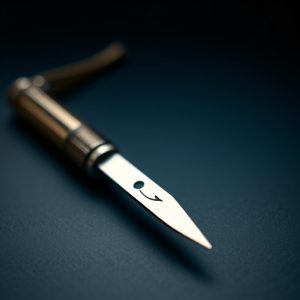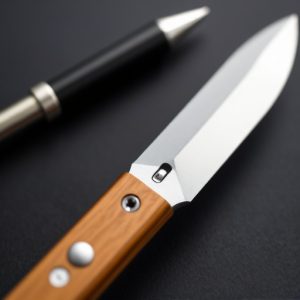Effective Self-Defense: Legalities and Usage of Pen Knives
When considering a pen with a knife for self-defense, it's crucial to evaluate its design and m…….
When considering a pen with a knife for self-defense, it's crucial to evaluate its design and material to ensure it's both ergonomic for everyday carry and effective as a defensive tool. The pen should be robust, conceal its blade discreetly, and function reliably under stress while adhering to legal requirements regarding blade length and ownership. Users must familiarize themselves with local laws to ensure the pen is not considered an illegal weapon. Proficiency with the pen requires specialized training that goes beyond mere possession; it includes mastering the mechanics of the pen, such as deploying the knife swiftly and safely, as well as practicing target acquisition and aiming. Regular training in different environments is essential to maintain readiness for a wide range of defensive scenarios. This ensures that the pen with knife capabilities serves as an effective and inconspicuous component of your personal protection strategy.
Exploring the multifunctional role of a pen with knife as a self-defense tool, this article dissects its practicality, legal implications, mechanics of use, and selection criteria. Delve into the nuances that distinguish it from other defensive instruments, and understand how to wield it effectively within the confines of the law. Whether for personal safety or as a discreet companion, the pen with knife merits a comprehensive examination for those considering it as part of their defense arsenal.
Understanding the Pen with Knife: A Practical Self-Defense Tool
The pen with knife represents a dual-purpose tool that combines the functionality of a writing instrument with a concealed self-defense weapon, making it a practical choice for individuals seeking a versatile self-defense tool. This innovative design ensures that users have both the means to communicate and defend themselves in potentially threatening situations. The primary feature of this tool is its compact size, allowing for easy carry without drawing attention or raising concerns about carrying a traditional defensive knife. In public areas where legal restrictions may apply to concealed weapons, the pen with knife can be discreetly used without compromising on self-defense readiness.
When considering the pen with knife as a self-defense tool, it’s important to focus on its operational aspects and legal considerations. The knife component is typically accessed by disassembling the pen, revealing a sharp blade intended for personal protection. Users must familiarize themselves with the quick-release mechanism to deploy the knife efficiently in an emergency. Training and practice are crucial to ensure proficiency in using the pen with knife effectively, as it serves not only as a deterrent but also as a last line of defense. Additionally, it’s essential to be aware of local laws regarding the possession and use of such tools to avoid legal repercussions. The pen with knife is a versatile self-defense solution that combines utility and safety, offering users a reliable option for personal protection in various environments.
Legal Considerations When Carrying a Pen with Knife for Self-Defense
When considering a self-defense tool, a pen with a knife feature can be a practical and discreet choice for personal protection. However, it’s crucial to navigate the complex legal landscape surrounding such devices. The legality of carrying a pen with a knife for self-defense varies by jurisdiction, with some regions permitting them under specific conditions while others may strictly regulate or even ban them altogether. Prospective owners must familiarize themselves with local laws, which often distinguish between different types and sizes of knives.
Understanding the intent behind the possession of a pen with a knife is as important as knowing the legal definitions and restrictions. Self-defense laws are designed to protect individuals from harm but also aim to prevent the abuse of weapons in a manner that could endanger the public. Therefore, it’s essential to be aware of how such devices are classified—whether they fall under self-defense tools or are considered offensive weapons. Additionally, knowledge of the circumstances under which one can legally use the pen with a knife in self-defense is paramount. This includes both the process of retrieving and deploying the knife in a threatening situation and the force that can be used if confronted. Always ensure compliance with local laws to avoid unintentional legal complications, as the consequences of misuse can be severe.
The Mechanics and Safety of Using a Pen with Knife in Self-Defense Situations
When considering a self-defense tool that offers both concealability and utility, a pen with knife mechanics stands out for its practicality. This device is designed to function as an everyday carry item, blending into daily life while providing a measure of protection when needed. The pen’s outer layer houses a retractable, compact blade, often accessible through a discrete mechanism that ensures the knife remains hidden until deployment is intentional and immediate. In self-defense situations, the user can quickly extend the blade to deter an aggressor or defend oneself. Safety features are paramount in such designs; a secure lock prevents accidental deployment of the blade, mitigating the risk of injury during regular use. Additionally, the blade’s length is carefully calculated to comply with legal standards while still being effective for self-defense. Users should familiarize themselves with local laws regarding the carry and use of such devices to ensure compliance.
The effectiveness of a pen with knife as a self-defense tool also hinges on proper technique and practice. It is not merely a weapon but an extension of one’s intent to protect oneself. Users must be adept at deploying the blade swiftly, handling it safely, and employing it in a manner that maximizes its defensive capabilities while minimizing potential harm. Training with the pen knife can include situational awareness exercises, response drills, and understanding the legal implications of using it in self-defense. Regular maintenance is crucial to ensure the mechanical components function correctly under pressure, which can be as critical as the physical conditioning necessary for a potentially dynamic encounter. Safety, both personal and legal, should always be at the forefront when considering the use of such tools in self-defense situations.
Choosing the Right Pen with Knife: Factors to Consider for Effectiveness and Legality
When selecting a self-defense pen with a knife, also known as a kubotan, it’s crucial to consider both its effectiveness in a self-defense scenario and its legality. The design and construction of the pen play pivotal roles in determining its utility. A sturdy, durable material ensures longevity and reliability under stress. The knife component should be concealed within the pen’s structure to maintain a non-threatening appearance while still being accessible for defense. The size and shape of the pen are also significant; they must be ergonomic for everyday carry comfort but also designed to maximize effectiveness if used in self-defense. Additionally, the weight distribution within the pen can affect its balance and how it feels in hand, influencing both the user’s control and the impact when used as a striking tool.
Legality is an equally important factor when choosing a pen with a knife for self-defense. Local laws vary significantly, and what is legal in one jurisdiction may be considered a prohibited weapon in another. It’s imperative to research and understand the specific statutes that govern the possession of such items. Key considerations include the length of the blade, the overall length of the pen when extended, and any local ordinances or state laws that apply. Manufacturers often provide guidance on where their products can be legally owned and carried, which should be reviewed alongside official legal resources. Always prioritize legal compliance to avoid unintentional possession of an illegal item, as this could lead to unwanted legal consequences. By carefully considering both the functional aspects and the legal framework surrounding a pen with a knife, individuals can make informed decisions that align with their self-defense needs while adhering to the law.
Training and Practice: Mastering the Use of a Pen with Knife for Personal Protection
When considering personal protection, a pen with knife capabilities can serve as both a discreet and effective self-defense tool. Mastery of this device goes beyond mere possession; it requires dedicated training and consistent practice to ensure proficiency in its use. An individual must familiarize themselves with the mechanics of the pen, understanding how to deploy the blade swiftly and safely under pressure. Training should commence with a thorough examination of the pen’s components, learning to extend and retract the knife without drawing attention or compromising one’s stance.
Once the user is comfortable with the deployment process, it’s crucial to practice target acquisition and aiming. This skill set involves honing the ability to swiftly bring the pen to bear in a defensive situation, ensuring that the blade is aligned correctly for maximum effectiveness. Drills focusing on drawing and deploying the knife while maintaining eye contact with potential threats can simulate real-world scenarios, building confidence and reflexes. Regularly scheduled training sessions, ideally weekly or biweekly, will help solidify these skills, making the pen with knife a reliable component of one’s self-defense arsenal. Consistent practice under varying conditions—indoor, outdoor, low light, etc.—ensures that the user is prepared for a wide range of potential confrontations.


